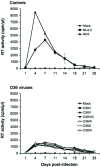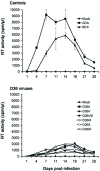Macrophage Tropism and Cytopathicity of HIV-1 Variants Isolated Sequentially from a Long-Term Survivor Infected with nef-Deleted Virus
- PMID: 19088897
- PMCID: PMC2589664
- DOI: 10.2174/1874285800701010001
Macrophage Tropism and Cytopathicity of HIV-1 Variants Isolated Sequentially from a Long-Term Survivor Infected with nef-Deleted Virus
Abstract
Long-term survival of human immunodeficiency virus type 1 (HIV-1) infection has been noted in rare cohorts of individuals infected with nef-deleted virus. Enhanced macrophage tropism and cytopathicity contribute to pathogenicity of wild type HIV-1. To better understand the pathogenesis of nef-deleted HIV-1, we analyzed the replication capacity and macrophage cytopathicity of nef-deleted HIV-1 isolated sequentially from a long-term survivor during progression to AIDS (n=6 isolates). Compared with controls, all nef-deleted viruses replicated to low levels in peripheral blood mononu-clear cells and monocyte-derived macrophages (MDM). One nef-deleted virus that was isolated on the development of AIDS caused high levels of syncytia in MDM similar to control viruses, but five viruses isolated from earlier times prior to AIDS onset caused only minimal cytopathicity. Together, these results suggest that enhanced cytopathicity of nef-deleted HIV-1 for MDM can occur independently of replication capacity, and may contribute to the pathogenesis of nef-deleted HIV-1 infection.
Figures



References
-
- Mikhail M, Wang B, Saksena NK. Mechanisms involved in non-progressive HIV disease. AIDS Rev. 2003;5:230–244. - PubMed
-
- O’Brien SJ, Moore JP. The effect of genetic variation in chemoki-nes and their receptors on HIV transmission and progression to AIDS. Immunol Rev. 2000;177:99–111. - PubMed
-
- Roger M. Influence of host genes on HIV-1 disease progression. FASEB J. 1998;12:625–632. - PubMed
-
- Chakrabarti L, Baptiste V, Khatissian E, et al. Limited viral spread and rapid immune response in lymph nodes of macaques inoculated with attenuated simian immunodeficiency virus. Virology. 1995;213:535–548. - PubMed
Grants and funding
LinkOut - more resources
Full Text Sources
